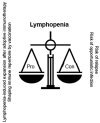Lymphoid reconstruction and vaccines
- PMID: 17222765
- PMCID: PMC1858644
- DOI: 10.1016/j.bbmt.2006.10.012
Lymphoid reconstruction and vaccines
Abstract
Allogeneic HSCT is the most reliable, robust, and effective cell-based biotherapy currently available to pediatric and adult patients with hematologic malignancies. The central role of donor-derived lymphocytes in mediating an effective antitumor effect, preventing and controlling opportunistic infections, and causing GVHD is well documented in animal experiments and human trials. The profound lymphopenia after conditioning regimens coupled with molecular tools to distinguish host versus donor cells provides investigators a window into immune recovery after allogeneic HSCT. Serial analyses of T cell subsets linking immunophenotype with function have revealed the kinetics of donor-derived T cell recovery after allografting and provided insights into ways the immune system can be manipulated to augment the graft-versus-tumor (GVT) effect without inducing GVHD. As this review demonstrates, investigators are not limited to being passive observers of this immune reconstitution; rather, we have an opportunity to shape the allografted T cells repertoire to selectively augment immune function.
Figures
Similar articles
-
Alloreactivity as therapeutic principle in the treatment of hematologic malignancies. Studies of clinical and immunologic aspects of allogeneic hematopoietic cell transplantation with nonmyeloablative conditioning.Dan Med Bull. 2007 May;54(2):112-39. Dan Med Bull. 2007. PMID: 17521527 Review.
-
Separation of graft-vs.-tumor effects from graft-vs.-host disease in allogeneic hematopoietic cell transplantation.J Autoimmun. 2008 May;30(3):172-9. doi: 10.1016/j.jaut.2007.12.002. Epub 2008 Jan 31. J Autoimmun. 2008. PMID: 18242060 Free PMC article. Review.
-
Multicenter phase 1/2 application of adenovirus-specific T cells in high-risk pediatric patients after allogeneic stem cell transplantation.Cytotherapy. 2018 Jun;20(6):830-838. doi: 10.1016/j.jcyt.2018.03.040. Epub 2018 May 9. Cytotherapy. 2018. PMID: 29753677 Clinical Trial.
-
Strategies for Enhancing and Preserving Anti-leukemia Effects Without Aggravating Graft-Versus-Host Disease.Front Immunol. 2018 Dec 21;9:3041. doi: 10.3389/fimmu.2018.03041. eCollection 2018. Front Immunol. 2018. PMID: 30619371 Free PMC article. Review.
-
Adoptive Immunotherapies After Allogeneic Hematopoietic Stem Cell Transplantation in Patients With Hematologic Malignancies.Transfus Med Rev. 2015 Oct;29(4):259-67. doi: 10.1016/j.tmrv.2015.07.001. Epub 2015 Jul 10. Transfus Med Rev. 2015. PMID: 26282736 Review.
Cited by
-
Thymic T-cell development in allogeneic stem cell transplantation.Blood. 2011 Jun 23;117(25):6768-76. doi: 10.1182/blood-2011-02-334623. Epub 2011 Mar 22. Blood. 2011. PMID: 21427289 Free PMC article. Review.
-
Myeloablative temozolomide enhances CD8⁺ T-cell responses to vaccine and is required for efficacy against brain tumors in mice.PLoS One. 2013;8(3):e59082. doi: 10.1371/journal.pone.0059082. Epub 2013 Mar 18. PLoS One. 2013. PMID: 23527092 Free PMC article.
-
Superior immune reconstitution using Treg-expanded donor cells versus PTCy treatment in preclinical HSCT models.JCI Insight. 2018 Oct 18;3(20):e121717. doi: 10.1172/jci.insight.121717. JCI Insight. 2018. PMID: 30333311 Free PMC article.
References
-
- Riddell SR, Murata M, Bryant S, Warren EH. T-cell therapy of leukemia. Cancer Control. 2002;9:114–122. - PubMed
-
- Naparstek E. The role of the anti-CD20 antibody rituximab in hematopoietic stem cell transplantation for non-Hodgkin's lymphoma. Curr Hematol Rep. 2005;4:276–283. - PubMed
-
- Kebriaei P, Saliba RM, Ma C, et al. Allogeneic hematopoietic stem cell transplantation after rituximab-containing myeloablative preparative regimen for acute lymphoblastic leukemia. Bone Marrow Transplant. 2006;38:203–209. - PubMed
-
- Cilley J, Winter JN. Radioimmunotherapy and autologous stem cell transplantation for the treatment of B-cell lymphomas. Haematologica. 2006;91:114–120. - PubMed
-
- Vose JM, Bierman PJ, Enke C, et al. Phase I trial of iodine-131 tositumomab with high-dose chemotherapy and autologous stem-cell transplantation for relapsed non-Hodgkin's lymphoma. J Clin Oncol. 2005;23:461–467. - PubMed
Publication types
MeSH terms
Grants and funding
LinkOut - more resources
Full Text Sources
Research Materials



